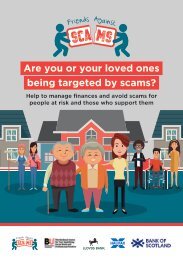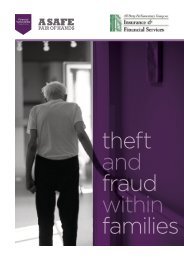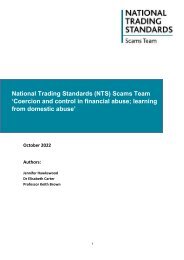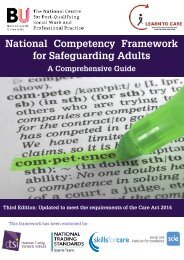Cyber Fraud and Scamming
This booklet focuses specifically on fraud and scamming; however cybercrime acts as a wider umbrella term, encompassing a range of criminal activity. Cybercrime can be simply defined as criminal activities carried out via the use of electronic devices, the internet and other forms of information and communications technology. The increasing use of computers and smartphones has facilitated a growth in the use of these systems as enablers of all types of crime, including: economic related cybercrime; organised crime; malicious and offensive communications; cyber stalking and harassment; and cyber terrorism.
This booklet focuses specifically on fraud and scamming; however cybercrime acts as a wider umbrella term, encompassing a range of criminal activity. Cybercrime can be simply defined as criminal activities carried out via the use of electronic devices, the internet and other forms of information and communications technology. The increasing use of computers and smartphones has facilitated a growth in the use of these systems as enablers of all types of crime, including: economic related cybercrime; organised crime; malicious and offensive communications; cyber stalking and harassment; and cyber terrorism.
You also want an ePaper? Increase the reach of your titles
YUMPU automatically turns print PDFs into web optimized ePapers that Google loves.
<strong>Cyber</strong>-Dependent <strong>Fraud</strong><br />
<strong>Fraud</strong>ulent activity that can only be committed via the use of information communications<br />
technology, primarily targeting computers <strong>and</strong> networks. This type of cyber-crime poses the greatest<br />
threat to public services <strong>and</strong> businesses but can also affect individuals due to the collection of<br />
personal data, leading to further fraudulent activity.<br />
The primary types of cyber-dependent crimes are:<br />
Hacking: The unauthorised use of, or<br />
access into, computers <strong>and</strong> networks, by<br />
exploiting vulnerabilities. This access<br />
can then be used to gather personal data<br />
<strong>and</strong> information, of which the impact can<br />
be significant financial losses for larger<br />
organisations, but can also result in the<br />
personal <strong>and</strong> financial data of individuals<br />
being compromised, leading to further<br />
fraudulent activities.<br />
Disruption of Computer Functionality: Often referred<br />
to as ‘malware’ <strong>and</strong> distributed by unsolicited or junk<br />
mail. Malicious software is designed to interfere with<br />
how computers <strong>and</strong> networks function, most frequently<br />
seen in the form of viruses, worms, Trojans, spyware<br />
<strong>and</strong> ransomware. Malware performs functions such as;<br />
undertaking hidden or unauthorised actions, damaging<br />
or deleting hardware, software or files, gathering<br />
sensitive <strong>and</strong> personal information or monitoring<br />
activity.<br />
Other types of Disruption of Computer Functionality, such as Denial-of-Service (DoS) <strong>and</strong> Distributed<br />
Denial-of-Service (DDoS) attacks, most frequently aimed at organisations <strong>and</strong> businesses rather than<br />
individuals, are designed to interrupt or suspend services <strong>and</strong> systems <strong>and</strong> make web-based services<br />
unavailable to users.<br />
<strong>Cyber</strong> -Enabled <strong>Fraud</strong><br />
Offenses which can be committed without the use of<br />
information communications technology but can be increased<br />
in their scale, impact <strong>and</strong> reach by the use of computers <strong>and</strong><br />
computer networks. <strong>Cyber</strong>-enabled frauds are similar to those<br />
carried out via other mediums, such as mail, telephone <strong>and</strong><br />
doorstep scams, but can often target individuals on mass,<br />
increasing the number of potential targets.<br />
This section will look at the most common types of cyberenabled<br />
fraud <strong>and</strong> provide some examples. This is by no means<br />
an exhaustive list <strong>and</strong> one type of fraud can overlap with<br />
another. <strong>Cyber</strong>-enabled frauds, as with mail <strong>and</strong> telephone<br />
frauds, are constantly evolving as the public becomes aware<br />
<strong>and</strong> as scammers adapt. Acts of fraud, however, do follow certain<br />
patterns of behaviour. This section is designed to help you spot<br />
the common identifiable signs of scams <strong>and</strong> take appropriate<br />
action.<br />
<strong>Cyber</strong>-enabled<br />
frauds are the most<br />
common form of<br />
all cybercrime <strong>and</strong><br />
fraud offences with<br />
over half of fraud<br />
incidents reported in<br />
the Crime Survey for<br />
Engl<strong>and</strong> <strong>and</strong> Wales<br />
being cyber related<br />
(ONS, 2018).<br />
The majority of cyber-enabled frauds can be aligned with the following four broad<br />
categories:<br />
Authorised Push<br />
Payment Scams<br />
Advance Fee<br />
<strong>Fraud</strong><br />
Consumer <strong>and</strong><br />
Retail <strong>Fraud</strong><br />
Bank <strong>and</strong> Credit<br />
Card <strong>Fraud</strong>
















